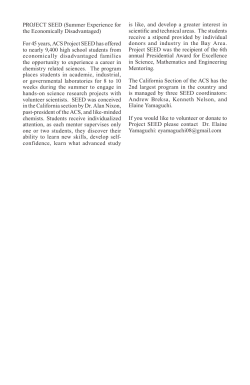
May 2015 - Conservation Agriculture Knowledge Resources
TWO WHEEL TRACTOR NEWSLETTER – MAY 2015 Special Indonesian Issue In late April/early May I had the privilege of visiting Indonesia, courtesy of the Syngenta Foundation (Project manager - SE Asia Clive Murray). Two training workshops for introduction to Two wheel tractors (2WT) and small 2WT seeders were held at a cropping site near the city of Bandar Lampung on the island of Sumatra, about 250 Km west of Jakarta. Each workshop consisted of around 30 persons, half of whom were farmers and the other half farmer support personnel (Seed company reps. Pesticide reps. etc.) The aim of the workshops was to introduce these two groups to the broad concept of small farm mechanisation and conservation agriculture. Participants were shown the principles of operation and maintenance of 2WT and also the setup and operation of three 2WT seed drills. Background to the trip. Indonesia is a country in SE Asia, with population of around 250 million people. The nation consists of several large islands (Java, Sumatra, Papua, Sulawesi, Kalimantan) and many smaller ones. It has a total land mass of around 1.9m. sq.Km . Around 13% is arable which gives a total area of around 24 m. hectares available for cropping. Principal grain crops are rice (11 m hectares) and maize (3.5 m. hectares) Significant areas of mung beans and other crops are also grown. However all of the maize and most of the rice is sown and harvested by manual labour methods. There are very few ‘commercial farms’ in the cropping sector and practically no small farm mechanisation. The only exception is a significant number of 8.5 -10HP 2WT which are principally used in paddy rice production. By way of example, maize crops are normally planted at a seed rate of 66,000 seeds/hectare. Many farmers employ contract teams who plant the maize with dibble sticks. A normal team of 5-10 persons will plant one hectare per day. Cost to the farmer is around $100. Contrast this with a farmer with a 2WT two row seed drill who can plant one hectare of maize under normal operating conditions in around 4 hours! Syngenta Foundation (SFSA) is a non-profit organization based in Basel, Switzerland whose mission is to create value for resource-poor smallholder farmers in developing countries. SFSA does this by supporting innovation in sustainable agriculture to ultimately find ways to improve farmer incomes and mechanization. This has been identified as a major constraint to income improvement in the number of countries. In broad terms, the initiative in mechanization is to introduce the Indonesian farmer to some simple forms of small farm mechanisation, principally with 2WT. This is part of a wider project with Syngenta Foundation and other partners (such as CIMMYT) to enable small holder farmers access to appropriate scale farm mechanisation and conservation agriculture in many countries of the developing world. Conduct of the Workshops. As the area is one that has maize as a significant crop, the workshops were mainly concerned with the mechanisation of maize planting with a 2WT. Two seed drills that had been imported by Syngenta Foundation were operated each day- those being the ARC Gongli, and also the Chinese 2BYF-2 maize planter from Yucheng Zhongkehuakai Machinery Co... Both of these were tine opener planters. A 2BFG100 rotary tillage planter was also on display, although not operated. The traction unit used was a DF-15 2WT, fitted with the standard implement adaptor hitch. Also being shown was a ’Quick’ 8.5HP 2 WT tractor fitted with a front mounted broadcast fertilizer spreader. The Quick 2WT is made in Indonesia, and is basically the same design as the Thai made ‘Siam Kubota’ range of 2WT. Attendees at the workshop listen to the introductory remarks. Teddy Tambu (Syngenta Indonesia) and Clive Murray (Syngenta SE Asia) setting up the 2BYF-2 two row maize drill The ARC Gongli being assembled for the demonstration Teddy gives instruction to the participants (2BYF-2 left – ARC Gongli right.) Participants operate the ARC Gongli in the field (note zero tillage- field previously sprayed with Roundup) Operating the 2BYF-2 in the same field. The ‘Quick’ 8.5HP 2WT being demonstrated with a front mounted fertiliser broadcaster. A group photo of all of the participants at the conclusion of the first day workshop. Some observations of the seed drills. The ARC Gongli did a reasonable job of planting maize. The unit could easily be calibrated and altered to adjust seed rate, although the seed spacing for maize with the dual fluted roller meters was a little uneven. Some operators found that the unit was somewhat unwieldy to turn at the end of the row. Adjustment of seeding depth was simple, due to the pin adjustment on each tine. Row (line) spacing and tine layout were also easily adjusted by loosening and/or moving the U bolts and tine assemblies on the tool bars. The Chinese 2BFY-2 row crop planter at first glance looked good. It was fitted with a spoon feed seed metering system. However there are in my opinion some major faults. First – the seed rate cannot be altered, unless further alternative drive sprockets are available. The single rate delivered was 60,000 seeds per hectare. Second – the tines are fixed and cannot be altered. Planting depth is altered by an adjustable hitch on the front of the implement, and also a spring loaded mechanism on the press wheels. However the range of adjustment was poor and the planting depth altered significantly once the operator stood on, or dismounted from, the stand at the rear. Third- Although the implement was allegedly designed to fit a Chinese DF type 2WT, the fertiliser boxes could not be positioned or fitted without major modification. There were quite a few minor faults as well. Further details on request. Some observations on seeding technology in the humid tropics. As some of you may know, I spent a professional career with CA cropping systems in a semi-arid zone in Australia. In many years soil conditions at planting were verging on too dry. The initial setup of seed drills in the tropics showed me that in areas such as Indonesia, the reverse is the norm. One must learn all over again the techniques for crop planting when the soil is nearing too wet. Some conclusions from the workshops. There is enormous interest in small farm mechanisation as shown by the participants at the two workshops. Although the ARC Gongli was by far the better seed drill, it is in the opinion of many too heavy and awkward for present use in Indonesia. Participants commented that the most common 2WT’s now readily available and being used in Indonesia are the Quick 8.5-10HP models (or their clones). A 2WT of this power range will only operate a single row seed drill for the planting of maize or other upland crops. There are currently several single row planters available (either designed for animal traction or small 2WT). In the opinion of the Syngenta staff, and other agricultural support representatives that attended, initial emphasis should be put on the development of a single row planter to suit this traction unit. Indonesian manufacturers are, in the opinion of the group, capable of fabricating a suitable single row unit, specifically designed for local conditions. Suitable affordable seed metering units, as well as fertiliser meters would initially be the only parts to be imported. Although a single row unit has half the work rate of a two row unit, it has a lower capital cost, and will be a significant improvement on the current system. Initial investigations for the design of a suitable unit have already commenced. ===================================== If you have any comment on this newsletter, please let me know. Back issues of the 2WT Newsletter can be found at :http://conservationagriculture.mannlib.cornell.edu/pages/resources/twowheel.html Note: This newsletter has been sent in a low resolution pdf. format for those on slow internet connections. If you require the newsletter or parts of it in higher resolution please let me know. R. J. Esdaile, Agricultural Consultant, 22 Meadowbanks Drive, TAMWORTH NSW 2340 Australia. Email: rjesdaile@bigpond.com rjesdaile@gmail.com (alternate) E. & OE.
© Copyright 2025









